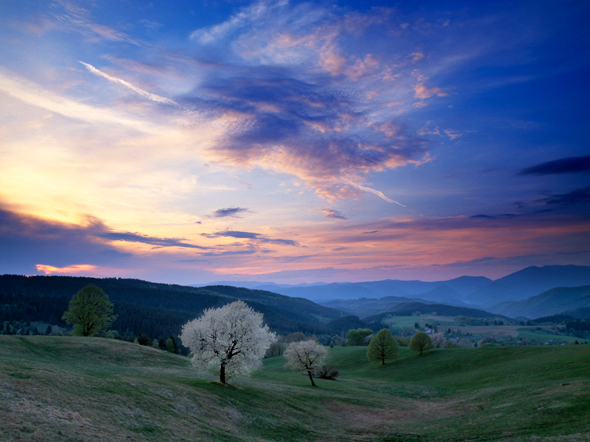Pre verziu v slovenčine, kliknite na lightharmony.com .
Film or digital? Both!
Whenever I'm out with my Hasselblad putting it up for a shot, I keep asking myself this particular question. The beauty of my setup is that I can switch between the two within seconds. No more I spend removing the film cassette and replacing it with Phase One digital back (and okay, placing a crop mask on the ground glass). I'm actually fortunate to have a choice, which is exactly why I designed my kit this way. I personally prefer film for its depth, contrast, color rendition and factor of unpredictability, but digital helped me out countlessly in many situations when using film was not appropriate or too risky as I badly needed an instant feedback (photographing in a snow storm in the night; or once-in-a-lifetime shooting in the Slovak caves). Hence when there's only a little bit of light out there and a scene is not extremely dynamic in lights and shadows, my first option is usually Fuji Velvia. One of the reason I avoid my Phase One is that many times, its raw file leaves me with colors washed out more than what I remember. I then suffer behind the computer to reconstruct feelings I had when the shutter was triggered. But perhaps it's just the matter of training to see "digitally" on one side, combined with the addicting element of Velvia vibrant output that do not need to be restored by Photoshop on the other side. Anyway, I like the flexibility for the time being and this is why.
Normally, I do not photograph the same scenery both ways but I made an exception here. Initially, the lighting could not be more boring so two friends I was with left before they could have pulled cameras out. I stayed on to do some tests so that I had not travelled to Slovakia to no avail. At sunset, some colors appeared on the horizon so I used film:
Camera: Hasselblad H1, Lens: 35mm, Film: Fuji Velvia 50, Filters: Lee ND Graduated 0.6, Exposure: Unrec.
I tried to create a rhythm with trees in the foreground while direct the lens upwards to the sky to record the interesting cloud formation above them. In the post-process, I darkened the sky a little bit, brought whites of the cherry tree up and reduced reds from greens to achieve what I photographed. I also was not too happy about the tree on the left and because I do not have a zoom, I went closer but the cherry started to get through the horizon hence I returned back decided to use Phase One with the same setup counting on its 1.3 crop factor. The tree would partially remain in the frame but a small crop healed it:
Camera: Hasselblad H1, Lens: 35mm, Film: Phase One P30, ISO: 100, Filters: Lee ND Graduated 0.6, Aperture: f/11, Exposure: 0.1s
To be fair, the colors faded and cloud formation came apart in the meantime (it took me 10-15 minutes to go down, try to compose and come back). I post-processed the digital file similar way as the above. I know that it can be tuned up some more but I sense it would not look natural with my PS skills. Comparing the two, I prefer the composition of the second one but at the same time, my taste favors Velvia rendition, which I find more lively while having a stronger character and feel of the place, even despite too much reds in the sky and blues on the horizon hills. (And yeah, the airplane line should be removed from both). So to conclude, for the final version I decided to return back to my original compositional intention while keeping the transparency colors:
I cropped the image vertically to tighten and emphasize the rhythm of trees and keep the better lighting and more vibrant colors. Plus, the formation in the sky seems to work better also. Cropping half of the frame means losing half of the size so I'm going from originally scanned 36MPx file (approximately 60x40cm at 300dpi) to some 18MPx. Still good enough for 80x60cm print of excellent quality if professionally enlarged.
I know this result won't fit everybody's preferences but I just tried to offer a comparison of what and why suits me. Let me know what you think!



